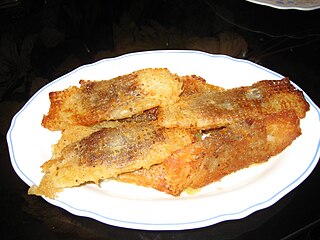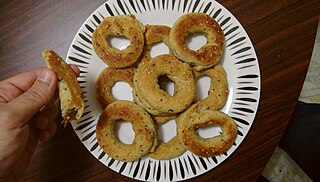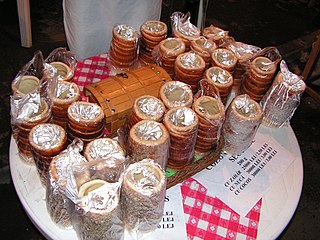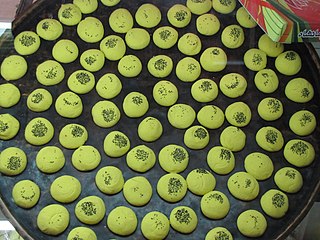
Turkish cuisine is largely the heritage of Ottoman cuisine, which can be described as a fusion and refinement of Mediterranean, Balkan, Middle Eastern, Central Asian, Eastern European, Armenian, and Georgian cuisines. Turkish cuisine has in turn influenced those and other neighbouring cuisines, including those of Southeast Europe (Balkans), Central Europe, and Western Europe. The Ottomans fused various culinary traditions of their realm with influences from Mesopotamian cuisine, Greek cuisine, Levantine cuisine, Egyptian cuisine, Balkan cuisine, along with traditional Turkic elements from Central Asia, creating a vast array of specialities.

Halva refers to various local confection recipes. The name is used for referring to a huge variety of confections, with the most geographically common variety based on toasted semolina.

Dough is a thick, malleable, sometimes elastic paste made from grains or from leguminous or chestnut crops. Dough is typically made by mixing flour with a small amount of water or other liquid and sometimes includes yeast or other leavening agents, as well as ingredients such as fats or flavorings.

A semla, vastlakukkel, laskiaispulla or fastlagsbulle/fastelavnsbolle is a traditional sweet roll made in various forms in Sweden, Finland, Estonia, Norway, Denmark, the Faroe Islands and Iceland, associated with Lent and especially Shrove Tuesday in most countries, Shrove Monday in Denmark, parts of southern Sweden, Iceland and Faroe Islands or Sunday of Fastelavn in Norway. In Sweden it is most commonly known as just semla, but is also known as fettisdagsbulle. In the southern parts of Sweden, as well as in Swedish-speaking Finland, it is known as fastlagsbulle. In Estonia it is called vastlakukkel. In Norway and Denmark it is called fastelavnsbolle. In Iceland, it's known as a bolla and served on Bolludagur. In Faroe Islands it is called Føstulávintsbolli, and is served on Føstulávintsmánadagur. Semla served in a bowl of hot milk is hetvägg.

Levantine cuisine is the traditional cuisine of the Levant, known in Arabic as the Bilad al-Sham, which covers a large area of the Eastern Mediterranean. It is found in the modern states of Cyprus, Jordan, Lebanon, Israel, Palestine, Syria, as well as in northern Iraq and parts of southern Turkey near Adana, Gaziantep, and Antakya. Conversely, some of the dishes listed below may have early origins in neighboring regions, but have long since become traditions in the Levant.

Reshteh khoshkar is the traditional cookie for Ramadan in Gilan Province, Iran. It is made of rice flour, and filled with sugar, ground walnuts or hazelnuts, cardamom, cinnamon, ginger and spice, fried in hot oil or fat. Made of rice flour, wheat flour, sugar, almonds, walnuts, and cinnamon, it is slowly fried in oil. Rice flour batter is poured in a small container with multiple holes such that the rice batter runs out of it as fountain. This container is then used to make a pattern on a hot skillet with the running rice batter. The hot skillet firms up the rice batter and makes a thin patterned sheet of rice pastry. A filling of crushed walnuts, sugar and sometimes other ingredients is placed in the center of the pastry and folded securely. This is then fried in oil and enjoyed.
Palathalikalu is an Indian sweet dish made during Ganesh Chaturdi in the Delta region of Andhra Pradesh, India.

Ka'ak or kahqa is the common Arabic word for biscuit, and can refer to several different types of baked goods produced throughout the Arab world and the Near East. The bread, in Middle Eastern countries, is similar to a dry and hardened biscuit and mostly ring-shaped. This pastry is popular in Indonesia, and called as "kue kaak".

Kürtőskalács is a spit cake specific to the Székelys of Transylvania. Originally popular in the Hungarian-speaking regions of Romania, more predominantly the Székely Land, it became popular in both, Romania and Hungary. The first written record dates back to 1679 and was found in the village of Úzdiszentpéter, while the first recipe appears in a manuscript cookbook dated in 1781. Earlier a festive treat, now it is part of everyday consumption. In Transylvania, a similar pastry to Kürtőskalács is Baumstriezel, originating from the Saxon communities.

Baklava is a layered pastry dessert made of filo pastry, filled with chopped nuts, and sweetened with syrup or honey. It was one of the most popular sweet pastries of Ottoman cuisine.

Gâteau Basque is a traditional dessert from the Southern Basque region of France, typically filled with black cherry jam or pastry cream. Gâteau Basque with cream is more typical in the Northern Basque region of Spain.

Qurabiya is a shortbread-type biscuit, usually made with ground almonds. Versions are found in most countries of the Arab world, with various different forms and recipes.

Shekerbura, is an Azerbaijani dessert. It is a sweet pastry in half-moon shape, filled with ground almonds, hazelnuts, or walnuts, and sugar. Shekerbura, shorgoghal, and pakhlava are the iconic foods of Novruz holiday in Azerbaijan.

Kolompeh is an Iranian pastry baked in the city of Kerman. Kolompeh looks like a pie with a mixture of minced dates with cardamom powder and other flavoring inside. Dates, wheat flour, walnuts and cooking oil are the main ingredients. Pistachios or sesame powder are often used for decorating kolompeh.

Nan-e nokhodchi, also called shirini nokhodchi, are cookies made from chickpeas originating in Qazvin, Iran. These are traditionally made from chick-pea flour and flavored with cardamom and garnished with pistachio. They come in varying shapes.

Nan-e berenji, also called shirini berenji, is an Iranian rice-flour cookie originating from Kermanshah. Nan-e berenji literally translates to "rice bread". It is often flavored with cardamom, garnished with poppy seeds and formed into flat disks. They are usually white, but sometimes tinted yellow.

Arab Indonesian cuisine is characterized by the mixture of Middle Eastern cuisine with local Indonesian-style. Arab Indonesians brought their legacy of Arab cuisine—originally from Hadhramaut, Hejaz and Egypt—and modified some of the dishes with the addition of Indonesian ingredients. The Arabs arrived in the Nusantara archipelago to trading and spread Islam. In Java, since the 18th century AD, most of Arab traders settled on the north coast and diffuse with indigenous, thus affecting the local cuisine culture, especially in the use of mutton meat and ghee in cooking.
Lauzinaj also spelt lawzinaj, lawzinaq, luzina is an almond-based confection known from medieval Arab cuisine. Described as the "food of kings" and "supreme judge of all sweets", by the 13th-century lauzinaj had entered medieval European cuisine from the Andalusian influence, returning Crusaders and Latin translations of cookery books.
















